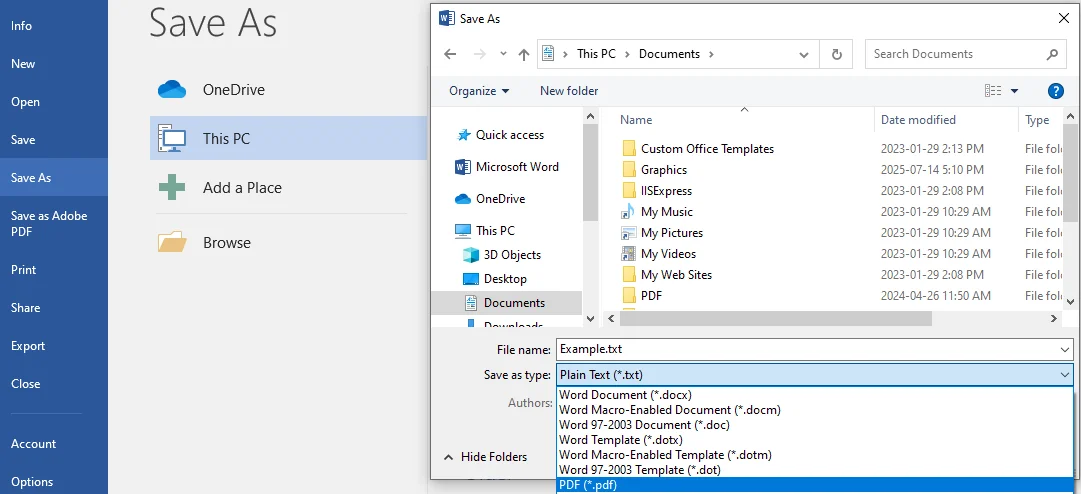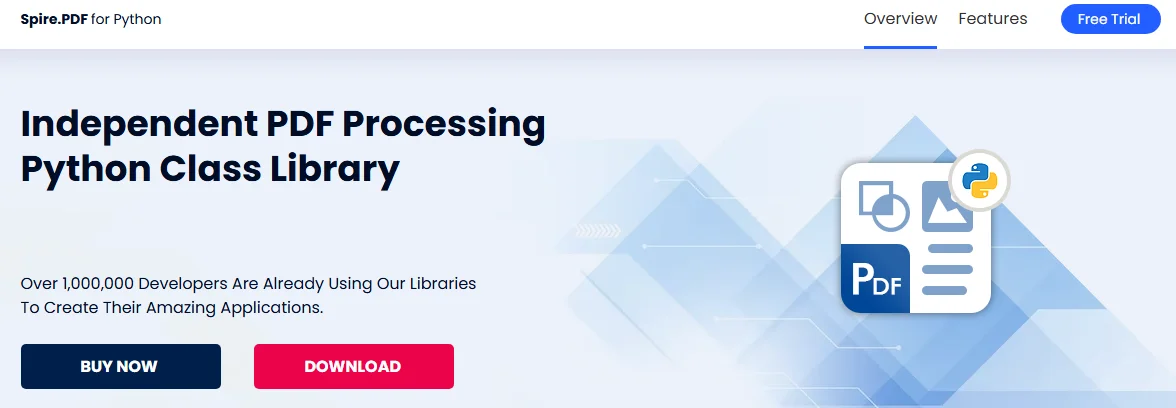Table of Contents
- Overview
- Why Convert Text to PDF
- Method 1: Use Built-in OS Features to Convert Text to PDF
- Method 2: Convert Text to PDF Online for Free
- Method 3: Save Text Files as PDF Using Microsoft Word
- Method 4: Automate Text to PDF Conversion with Python
- Conclusion: Choose the Best Method to Convert Text to PDF
- Frequently Asked Questions (FAQs)
Install with Pypi
pip install Spire.Pdf
Related Links

Table of Contents
- Overview
- Why Convert Text to PDF
- Method 1: Use Built-in OS Features to Convert Text to PDF
- Method 2: Convert Text to PDF Online for Free
- Method 3: Save Text Files as PDF Using Microsoft Word
- Method 4: Automate Text to PDF Conversion with Python
- Conclusion: Choose the Best Method to Convert Text to PDF
- Frequently Asked Questions (FAQs)
Overview
Converting text files to PDF is a common need for students, professionals, and developers. While plain text (.txt) files are simple and lightweight, PDFs provide consistent formatting, better control, and advanced features, making them ideal for professional documents, large-scale sharing, or secure storage.
In this guide, you'll discover 4 easy ways to convert text to PDF-using built-in OS features, free online tools, Microsoft Word, or Python for automated batch conversions. Each method includes step-by-step instructions so you can quickly choose the approach that fits your needs. Whether you want a quick one-off conversion, a polished professional document, or automated PDF creation, this guide has you covered.
Why Convert Text to PDF
Converting text files to PDF offers several important advantages over plain .txt documents:
- Universal compatibility: PDFs open consistently on any device, regardless of operating system or software.
- Professional appearance: Apply custom fonts, headings, spacing, page breaks, and branding for polished, presentation-ready documents.
- Enhanced security: Add passwords, encryption, digital signatures, or watermarks to protect sensitive information.
- Archival and long-term access: PDF/A compliance ensures your documents remain accessible and properly formatted for years.
- Easy sharing and distribution: PDFs are ideal for business reports, contracts, eBooks, and other documents that need to be widely shared without formatting issues.
By turning text files into PDFs, you transform simple plain text into a professional, secure, and widely compatible format suitable for both personal and business use.
Method 1: Use Built-in OS Features to Convert Text to PDF
Most modern operating systems include a built-in "Print to PDF" feature that allows you to quickly save text files as PDFs without installing extra software. This method is best for casual users who only need basic conversions.

Steps to Convert Text Files to PDF on Windows and macOS:
- Windows: Open the .txt file in Notepad, go to File > Print, and select Microsoft Print to PDF.
- macOS: Open the .txt file in TextEdit, press Cmd + P, and choose Save as PDF.
Pros:
- Quick and free (no extra software needed)
- Works offline and supports any .txt file
- Available across all major operating systems
Cons:
- Limited customization (fonts, margins, and styling cannot be changed)
- Basic PDFs only - no metadata, watermarks, or encryption
- Not suitable for professional or bulk conversions
Tip: If you don't see the Microsoft PDF Printer installed on your Windows system, refer to this article to add or reinstall it: How to Add or Reinstall the Microsoft PDF Printer.
Method 2: Convert Text to PDF Online for Free
If you want to turn your text files into PDFs online in your browser, online converters like Sodapdf provide a convenient solution. This approach is useful for quick one-off conversions when you have an internet connection.

Steps to Convert Text Files to PDF Online for Free:
- Drag a text file into the Sodapdf's TXT to PDF converter.
- The file converts instantly after upload.
- Download the converted PDF.
Pros:
- No installation required - works directly in the browser
- Simple and user-friendly interface
- Available on any device (desktop, tablet, mobile)
Cons:
- Privacy risks - sensitive files are uploaded to third-party servers
- Requires an internet connection
- Limited advanced features (e.g., encryption, metadata, batch processing often behind paywalls)
Method 3: Save Text Files as PDF Using Microsoft Word
If you need to style your text before converting, word processors like Microsoft Word are an excellent option. It allows you to add fonts, headings, spacing, and even images before exporting to PDF.

Steps to Export Text Files to PDF in Microsoft Word:
- Launch Microsoft Word, go to File > Open, and select your .txt file.
- Apply formatting if needed (fonts, margins, page breaks, headers, footers, etc.).
- Click File > Save As, choose the location where you want to save the file.
- In the Save as type dropdown, select PDF (*.pdf).
- Adjust options if necessary (like page range or optimize for standard/minimum size).
- Click Save, and Word will create a PDF version of your text file.
Pros:
- Great for professional-looking documents
- Supports styling, tables, and images
- PDFs are searchable and well-formatted
Cons:
- Requires manual effort for formatting (time-consuming for large documents)
- Not ideal for bulk automation
- Requires Microsoft Word to be installed
Method 4: Automate Text to PDF Conversion with Python
For developers and IT professionals, Python provides programmatic control over text-to-PDF conversion. Using libraries like Spire.PDF for Python, you can automate large-scale conversions and customize fonts, layouts, and colors, and add encryption.

Steps to Convert Text to PDF in Python:
- Install Spire.PDF for Python from PyPI using the pip command:
pip install Spire.PDF - Import the required classes:
from spire.pdf import - Open the text file and read the content from it.
- Create a PDF document using PdfDocument().
- Add a page using pdf.Pages.Add().
- Create font and brush using PdfFont() and PdfBrushes.get_Black().
- Set text alignment and line spacing using PdfStringFormat().
- Define text layout using PdfTextLayout() with FitPage and Paginate options.
- Create a text widget to hold the text content using PdfTextWidget().
- Draw the text widget on the page using Draw().
- Save the PDF using SaveToFile() and release document resources.
Example Code:
from spire.pdf.common import *
from spire.pdf import *
inputFile = "input.txt"
outputFile = "TextToPdf.pdf"
# Read text directly from the txt file
with open(inputFile, 'r') as f:
text = f.read()
# Create a PdfDocument instance
pdf = PdfDocument()
# Add a page
page = pdf.Pages.Add()
# Create a PDF font and PDF brush
font = PdfFont(PdfFontFamily.TimesRoman, 11.0)
brush = PdfBrushes.get_Black()
# Set the text alignment and line spacing
strformat = PdfStringFormat()
strformat.LineSpacing = 10.0
strformat.Alignment = PdfTextAlignment.Justify
# Set the text layout
textLayout = PdfTextLayout()
textLayout.Break = PdfLayoutBreakType.FitPage
textLayout.Layout = PdfLayoutType.Paginate
# Create a PdfTextWidget instance to hold the text content
textWidget = PdfTextWidget(text, font, brush)
# Set the text format
textWidget.StringFormat = strformat
# Draw the text at the specified location on the page
bounds = RectangleF(PointF(0.0, 20.0), page.Canvas.ClientSize)
textWidget.Draw(page, bounds, textLayout)
# Save the result file
pdf.SaveToFile(outputFile, FileFormat.PDF)
pdf.Close()
Pros:
- Fully customizable (fonts, images, colors, page layouts)
- Ideal for automation and bulk processing
- Can add advanced features (page number, header/footer, encryption, metadata, watermarks)
Cons:
- Requires programming knowledge
- Setup takes longer than manual methods
- May need third-party libraries for complex styling
Conclusion: Choose the Best Method to Convert Text to PDF
Each method for converting text to PDF has its own strengths. The table below provides a clear overview:
| Method / Tool | Ease of Use | Customization | Security | Automation | Best Use Case |
|---|---|---|---|---|---|
| OS Print to PDF | Easy | Low - basic layout only | Low - no encryption or metadata | No | Quick, one-off conversions of simple text files |
| Online Converters | Easy | Medium - limited formatting | Low - files may be exposed online | No | Convenient for occasional use on any device with internet |
| Microsoft Word | Easy | Medium - supports fonts, tables, images | Medium - can add passwords | Limited | Professional-looking PDFs with styled text, headers, and footers |
| Python Libraries (e.g., Spire.PDF) | Moderate | High - full control of fonts, layouts, metadata | High - encryption and PDF/A support | Yes | Automated, bulk conversions with full customization and security |
How to Choose the Right Method?
- For simple, quick conversions: use OS Print to PDF or online tools.
- For styled, professional PDFs: use Microsoft Word.
- For automated or bulk processing: use Python libraries like Spire.PDF.
Frequently Asked Questions (FAQs)
Q1: Do I need an internet connection to convert text to PDF?
A1: Only online converters require internet access. OS built-in tools, Word, and Python libraries work offline.
Q2: Can I include images or tables when converting from plain text?
A2: Plain text itself does not contain images or tables, but you can insert them in Word or programmatically with Python before exporting to PDF.
Q3: Will converting text to PDF affect file readability on different devices?
A3: No. PDFs preserve text layout, ensuring consistent readability on PCs, Macs, tablets, and mobile devices.
Q4: Are there any security risks when using online converters?
A4: Yes. Uploading sensitive text files to third-party servers may expose confidential information. For secure documents, offline tools or programmatic methods are safer.
Q5: Can I convert text files to PDF in bulk without opening each file manually?
A5: Yes. Automation using Python scripts allows batch conversion of multiple text files into PDFs efficiently.